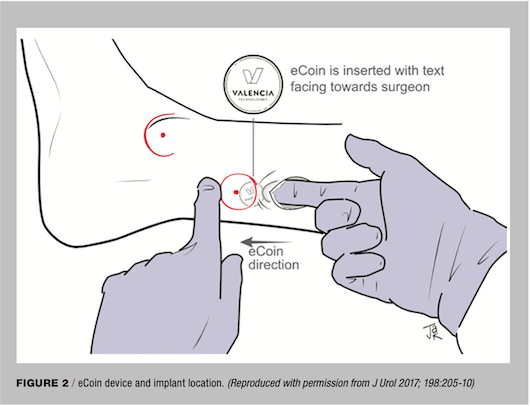Article
New developments may change treatment of OAB
Author(s):
"New treatments (pharmacological and device based) are currently in development to expand our OAB armamentarium," write Nathan Chertack, MD, and Gary Lemack, MD.
Overactive bladder (OAB) syndrome affects millions of individuals worldwide, with as many as 20% of the population affected. Current American Urological Association/Society of Urodynamics, Female Pelvic Medicine and Urogenital Reconstruction guidelines suggest a stepwise approach to management, starting with conservative strategies (behavioral modification and pelvic floor treatments), adding medications when needed (eg, anticholinergic and β-agonist medications), and moving on to advanced therapies (eg, onabotulinumtoxinA [Botox] detrusor injections as well as sacral and percutaneous neuromodulation) if less invasive strategies are ineffective or poorly tolerated.
New treatments (pharmacological and device based) are currently in development to expand our OAB armamentarium.
Drug therapy: β-agonists
The bladder receives both sympathetic (β-receptors-primarily relaxant) and parasympathetic (muscarinic receptors-primarily excitatory) innervation. Medical therapies may be directed at either to combat OAB, with antimuscarinics having been the mainstay of treatment for years. Mirabegron (Myrbetriq) is currently the only β-agonist available for the treatment of OAB and is generally well tolerated. Initial concerns for hypertension were not noted in the registration trials, though patients with poorly controlled hypertension should not be treated with this class of medications.
Vibegron is a new β-agonist currently in phase III clinical trials; its new drug application was recently accepted by the FDA. Initially developed for obesity treatment in the 1990s, it was found to improve OAB symptoms.1 Unlike mirabegron, it has no cytochrome P450 enzyme interactions.
Yoshida et al initially examined the efficacy of vibegron (both 50 mg and 100 mg) over a 12-week time frame and found that patients on vibegron demonstrated significant improvement in micturition frequency, daily urgency episodes, daily incontinence episodes, nocturia episodes, and volume per void when compared with placebo.2 Treatment effects were seen within 3 weeks of starting therapy. More than 90% of patients reported satisfaction after a vibegron treatment course, with adverse events (AEs) similar to placebo. Additional analyses revealed an improvement in nocturia and, as one would expect, an improved AE profile with regard to xerostomia in a comparative trial with tolterodine.3,4
Tibial neuromodulation
Percutaneous tibial nerve stimulation (PTNS) was developed and approved in the early 2000s, when it was demonstrated that weekly low-level electrical stimulation of the tibial nerve utilizing an acupuncture needle improved patient-reported OAB symptoms.5 Despite its benefits, PTNS requires frequent clinic visits (30-minute sessions weekly for 12 weeks, then typically every 4-8 weeks maintenance) and, in part, because of this schedule, has not been widely embraced. Additionally, the improvements in urge incontinence following PTNS do not appear to be as robust as with either onabotulinumtoxinA or sacral neuromodulation.

The concept of implantable tibial nerve stimulators is not new, with the Urgent-SQ developed in 2006 and 9-year results reported in 2013.6 However, the device was never manufactured or marketed and no further study results were reported.7 Recently, multiple companies have piloted implantable tibial neurostimulators in the hopes of bypassing the shortcomings of PTNS.
RENOVA (BlueWind Medical) is one such implantable device. A short (<45-minute) clinic-based procedure is required to place the 25-mm device next to the tibial nerve, just proximal to the medial malleolus through a 5-cm incision (figure 1). The device does not require batteries and is powered by an external control unit that is worn on the ankle only during treatments. An initial study that followed 15 patients for 3 months after implantation8 noted decreased void frequency, increased voided volume, and decreased episodes of urgency and urge incontinence. No complications were noted and patients reported no issues with operating the control unit.
A later study of 34 patients treated over 6 months demonstrated clinical success (>50% improvement in one or more study outcomes) in 67% of patients and no incontinence episodes in 28%. Almost half (47%) of patients reported acute AEs (mostly implant site pain, suspected wound infection). Three-year data from this initial cohort suggest long-term efficacy (success in >75% of patients) and diminished AE profile.9
Another device currently in development is the eCoin. A short (<20-minute) clinic-based procedure is performed under local anesthesia to implant the nickel-sized device into the medial lower leg (figure 2). The device is automatically set to provide stimulation every other day for 2 weeks, then twice per month.
Forty-six patients were implanted with the device and followed for 6 months.10 After activation, patients noted a 71% median reduction in the number of urge incontinence episodes at 12 weeks. Overall, 24% reported no urge incontinence episodes at 6 months. No patients required device revision or removal during the study, although one patient developed cellulitis and one patient developed device migration after vigorous exercise. Recent data suggest that efficacy has been maintained at 1 year following implantation.11

Two other tibial stimulation devices are currently in the early stages of development for OAB therapy. StimRouter consists of an implantable lead and a wireless control device. It has been shown to be efficacious in the treatment of patients with peripheral nerve pain and is currently being studied for OAB treatment.12,13 CAN-Stim also consists of an implantable lead and wireless control device. Patients are currently being enrolled in trials for comparison between implantable tibial and sacral neuromodulation.14
Conclusions
OAB syndrome is a widely prevalent disorder with a multitude of treatment options. Antimuscarinic medications may result in undesired side effects or lack of treatment efficacy, and overall, patients only uncommonly stay on medications long term. The development of vibegron as an alternative β-agonist and a variety of implantable tibial neurostimulators may soon offer patients with OAB a wider array of options for improving quality of life.

Nathan Chertack, MD

Gary Lemack, MD
Dr. Chertack is a urology resident and Dr. Lemack is professor of urology and neurology, UT Southwestern Medical Center, Dallas. Disclosure: Dr. Lemack serves on the clinical events committee for Blue Wind Medical and is a clinical investigator for StimGuard.

Section Editor Christopher M. Gonzalez, MD, MBA, is professor and chair of the department of urology at Loyola University Chicago Stritch School of Medicine, Maywood, IL.
References
1. Edmondson SD, Zhu C, Kar NF, et al. Discovery of vibegron: a potent and selective beta3 adrenergic receptor agonist for the treatment of overactive bladder. J Med Chem 2016; 59:609-23.
2. Yoshida M, Takeda M, Gotoh M, et al. Vibegron, a novel potent and selective beta3-adrenoreceptor agonist, for the treatment of patients with overactive bladder: a randomized, double-blind, placebo-controlled phase 3 study. Eur Urol 2018; 73:783-90.
3. Yoshida M, Takeda M, Gotoh M, et al. Efficacy of novel beta3-adrenoreceptor agonist vibegron on nocturia in patients with overactive bladder: a post-hoc analysis of a randomized, double-blind, placebo-controlled phase 3 study.Int J Urol 2019; 26:369-75.
4. Mitcheson HD, Samanta S, Muldowney K, et al. Vibegron (RVT-901/MK-4618/KRP-114V) administered once daily as monotherapy or concomitantly with tolterodine in patients with an overactive bladder: a multicenter, phase IIb, randomized, double-blind, controlled trial. Eur Urol 2019; 75:274-82.
5. Bhide AA, Tailor V, Fernando R, et al. Posterior tibial nerve stimulation for overactive bladder-techniques and efficacy. Int Urogynecol J Dec. 18, 2019 [Epub ahead of print].
6. Janssen DA, Farag F, Heesakkers JP. Urgent-SQ implant in treatment of overactive bladder syndrome: 9-year follow-up study. Neurourol Urodyn 2013; 32:472-5.
7. Janssen DA, Martens FM, de Wall LL, et al. Clinical utility of neurostimulation devices in the treatment of overactive bladder: current perspectives. Med Devices (Auckl). 2017; 10:109-22.
8. van Breda HMK, Martens FMJ, Tromp J, Heesakkers J. A new implanted posterior tibial nerve stimulator for the treatment of overactive bladder syndrome: 3-month results of a novel therapy at a single center. J Urol 2017; 198:205-10.
9. Dmochowski RR, Kerrebroeck PV, Digesu GA, et al. Long-term results of safety, efficacy, quality of life and satisfaction of patients treated for refractory OAB using an implantable tibial neurostimulation system: RENOVA ISTIM System. J Urol 2019; 201(suppl 4, abs. PD31-02):e565-6.
10. MacDiarmid S, Staskin DR, Lucente V, et al. Feasibility of a fully implanted, nickel sized and shaped tibial nerve stimulator for the treatment of overactive bladder syndrome with urgency urinary incontinence. J Urol 2019; 201:967-72.
11. MacDiarmid S, Lucente V, Kaaki B, et al. 12-month feasibility data of a fully-implanted, nickel-sized and shaped tibial nerve stimulator for the treatment of overactive bladder syndrome with urgency urinary incontinence. J Urol 2019; 201 (suppl 4, abs. LBA-06):e994.
12. Deer T, Pope J, Benyamin R, et al. Prospective, multicenter, randomized, double-blinded, partial crossover study to assess the safety and efficacy of the novel neuromodulation system in the treatment of patients with chronic pain of peripheral nerve origin. Neuromodulation 2016; 19:91-100.
13. Ferreira-Dos-Santos G, Hurdle MFB, Gupta S, Clendenen SR. Ultrasound-guided percutaneous peripheral nerve stimulation for the treatment of lower extremity pain: a rare case report.Pain Pract 2019; 19:861-65.
14. StimGuard website. Accessed Feb. 17, 2020. www.stimguard.com/.















